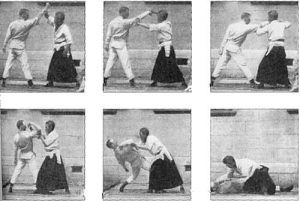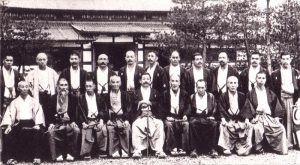During the Edo period (1600-1868) several Jujitsu styles became paramount. These schools focused their activities on various techniques that their masters had developed over time. The Kyushin Ryu school specialised in systems of Atemi waza (striking techniques). The art was practised by many shoguns who specialised in attacking the exposed target areas outside the armour of their opponent.
Credit for the foundation of the Kyushin Ryu school is given to Inugami Sakon Shogen Nagakatsu during the Eiroku period (1558-1569). During this time, he compiled a book explaining the basic principles of the style, which specialised in Atemi Waza (striking techniques – utilising the legs and arms) and Katsu Waza (methods of resuscitation and first aid response).

(Yazo Eguchi pictured above on right)
The most noteworthy master of Kyushin Ryu Jujitsu in more recent times is Shihan Yoshinori Eguchi, who received recognition during the formation stages of modern Judo by Dr Jigoro Kano in the early 1880s. Dr Kano selected techniques from the five major Jujitsu schools – Yoshin Ryu, Kito Ryu, Takenouchi Ryu, Daito Ryu and Kyushin Ryu. As such, Eguchi Shihan became one of Dr Kano’s closest disciples in the early Judo formation stages.

One of the senior students of Eguchi Shihan was Minehiko Nakano of Yamaguchi Prefecture. At the conclusion of World War 2, he resided in the city of Iwakuni near Hiroshima. This later became the site of an American marine base, and he was persuaded to interact with the Americans, and teach the art of Jujitsu. One member of the Australian occupational forces was Mr Ray Stevens of Brisbane. He too, learnt from Nakano, and brought the art to Brisbane in the early 1950s where he joined with Dr A.J. Ross and passed on his knowledge of the art to several martial arts practitioners, including John Lee Jones, Desmond de Vene, Jim Stackpoole and Joe Elkenhans.
Kyushin Ryu Jujitsu schools have been established in various parts of the world, and the most well known school was established in London in the late 1940s. While the traditional techniques expounded by Eguchi Shihan have been retained, various aspects of the art have been influenced by the changing times, especially in relation to safety. Apart from some adaptations to various techniques by other Jujitsu schools, the Kyushin Ryu School of Jujitsu is the only follower of the Kyushin Ryu style in Australia.
Pictured below is the working group for constructing the Kodokan kata syllabus. They met at the Dai Nihon Butokukai in Kyoto on July 24, 1906 for this photo. The Japanese below the photo gives their schools (ryu) beside their names.

Front row, left to right is:
…Masamizu Inazu of Miura Ryu
…Yazo Eguchi of Kyushin Ryu
…Takayoshi Katayama of Yoshin Ryu
…Kumon Hoshino of Shiten Ryu
…Jigoro Kano of Kodokan
…Hidemi Totsuka of Totsuka-ha Yoshin Ryu
…Jushin Sekiguchi of Sekiguchi Ryu
…Koji Yano of Takeuchi Ryu
…Katsuta Hiratsuka of Yoshin Ryu
Back row, left to right is:
…Kehei Aoyagi of Sosuishi Ryu
…Mogichi Tsumizu of Sekiguchi Ryu
…Hikosaburo Ohshima of Takeuchi Ryu
…Hoken Sato of Kodokan
…Kotaro Imei of Takeuchi Ryu
…Mataemon Tanabe of Fusen Ryu
…Shikataro Takano of Takeuchi Ryu
…Hidekazu Nagaoka of Kodokan
…Sakujiro Yokoyama of Kodokan
…Hajime Isogai of Kodokan
…Yoshiaki Yamashita of Kodokan
A BRIEF HISTORY OF JUJITSU
In The Beginning
There are no records by which the origins of Jujitsu can definitely be established. It is safe to assume that ever since the beginning of history, the instinct of self-preservation was strong and man had to fight for existence. The basic inspiration to develop a skill that allowed a person to use the body for offense and defense was the basis for all martial arts.
Muromachi Period (1333 – 1573)
Early Japanese warriors were highly skilled with the use of swords. They also required the ability to defend themselves when they were unable to use their sword. They studied and developed methods of striking, kicking, throwing, joint taking and choking. This was the formal beginning of Jujitsu although historical references of unarmed defense techniques date back to the 11th century. The early years of Jujitsu were secretive, each family or province had their own style, passing down these techniques only to other family or province members. As a result, specialization and compartmentalization developed. This process continued until the late 16th century when Jujitsu formalized and many significant ryu’s (schools) formed. A few of these styles greatly helped to form what we consider modern day Jujitsu.
The Formation – Edo Period (1600 – 1868)
The Kyushin-ryu school brought forward systems of Atemi-waza (striking techniques) and Kappo (systems of resuscitation). Kito-ryu brought forward an order of training methods from basic to advanced. Throwing techniques were also emphasized by this style and today’s modern day Judo is based upon this styles basic techniques. Takenouchi-ryu emphasized Hojo (rope tying techniques) which is currently used by many police and military groups. Daito-ryu specialized in Kansetsu-waza (joint techniques) and Atemi-waza. Today’s Aikido is based upon this style of joint techniques.
The Turning Point – Meiji Period (1868-1911)
In the late 1800’s the Japanese feudal system collapsed and imperial rule was re-established. Weapons were no longer allowed to be carried and many of the Jujitsu styles and Samurai began to die out. During this time period a few modern day styles emerged. Jigoro Kano developed Judo. Many tournaments between Judo and Jujitsu practitioners took place during this time period. Without the ability to strike and kick (Judo rules) the Jujitsu practitioner was limited in techniques and as a result, Judo often won. Jujitsu was even more reduced in practice and Judo became Japans principal martial art form. It was the Japanese police that lent revitalization to Jujitsu. They realized that striking and kicking techniques were still needed and took techniques that most satisfied their needs. They added them to Judo and developed the Jujitsu style Taiho-Jitsu. The name became synonymous with police and if a student studied this style, then it was assumed that they were a police officer.
Modern Day Jujitsu (1912 – Present)
By the commencement of the twentieth century, the notoriety of Jujitsu as a form of unarmed combat became more well known in western society. Many schools, wishing to protect the secrets of their origins, slowly became suppressed as many foreigners entered Japan and sought out the secrets of the art. By the time World War 2 ended, Japanese society had undertaken massive changes, and the status of the emperor, along with many traditional activities such as the martial arts, almost disappeared in history. During this time, the allied forces occupying Japan placed a ban on all forms of martial arts training. This was ordered, primarily to suppress any ability of the Japanese to rejuvenate their “aggressive” arts and offer resistance to the allies’ attempts to change the nature of the Japanese culture.
Gradually, the suppression imposed by western society after the war had eased, and several traditional Jujitsu schools in Japan reopened their doors. Leading the resurgence in Japan have been the police forces, who have adopted many Jujitsu techniques as part of their modern training procedures. Consequently, Jujitsu has re-emerged in various parts of Japan, and spread to the western world. One of the most prominent practitioners in Australian Jujitsu history, was Dr A.J. Ross who formed the first Jujitsu school in Australia in 1926 in Brisbane. Many of his disciples are principals of various Jujitsu schools throughout Australia today.
